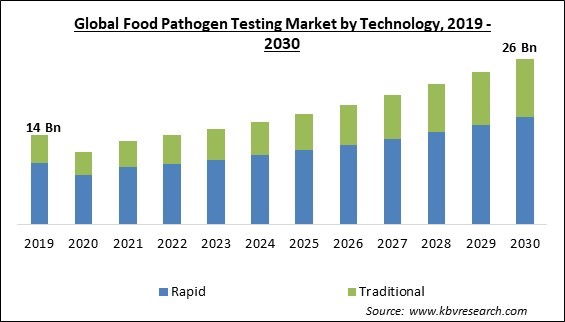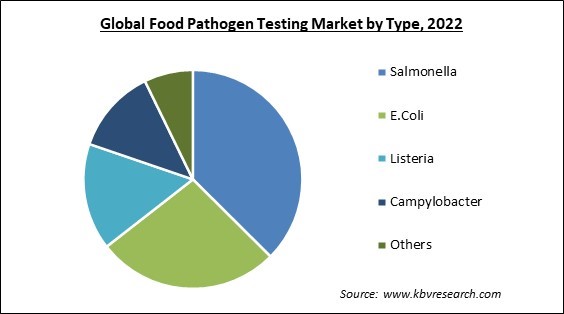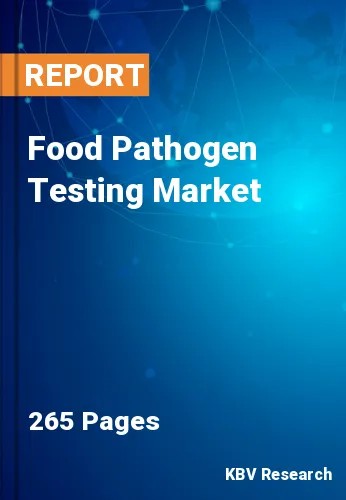The Global Food Pathogen Testing Market size is expected to reach $26.0 billion by 2030, rising at a market growth of 8.2% CAGR during the forecast period.
Testing is often conducted at meat and poultry processing plants, where large quantities of products are produced and packaged. Therefore, the Meat & Poultry segment is anticipated to capture approximately 1/4th share of the market by 2030. Regular testing helps identify and prevent contamination within these facilities. Contamination can occur at various meat and poultry production stages, from farms and slaughterhouses to processing plants and distribution. Pathogen testing is performed to detect and mitigate contamination risks at each stage. These factors help boost the demand in the segment. Some of the factors impacting the market are globalization of the food supply chain, stringent regulatory requirements by governing agencies, and high investment costs associated with testing technologies.

As the world becomes increasingly interconnected, food products are sourced from diverse geographic regions, making their way through complex supply chains before reaching consumers' plates. In summary, the globalization of the food supply chain brings both opportunities and challenges to the food industry. While it allows consumers to enjoy a diverse array of products, it also heightens the importance of food safety. As a result, pathogen testing becomes a critical tool in safeguarding the global food supply, ensuring that products are safe for consumption, and facilitating the continued growth of the market in the future. The Food and Drug Administration in the U.S., the European Food Safety Authority (EFSA) in Europe, and equivalent agencies worldwide enforce strict food safety regulations. Food producers and manufacturers must comply with these regulations, making pathogen testing obligatory. There is a growing trend toward harmonizing food safety standards globally. Regulatory authorities may require continuous food product monitoring and testing to ensure ongoing safety standards compliance. This encourages food producers to invest in pathogen testing as part of their routine quality control.
However, the high costs associated with food pathogen testing are a significant limiting factor in the market's growth. Implementing comprehensive and accurate pathogen testing methods often requires a substantial financial investment, posing challenges for large food manufacturers and smaller businesses. While these expenses are essential for maintaining food safety standards, they can be particularly challenging for smaller food producers and laboratories with limited budgets. Therefore, the high investment cost impacts various facets of the market.

The leading players in the market are competing with diverse innovative offerings to remain competitive in the market. The above illustration shows the percentage of revenue shared by some of the leading companies in the market. The leading players of the market are adopting various strategies in order to cater demand coming from the different industries. The key developmental strategies in the market are Acquisitions, and Partnerships & Collaborations.
Based on type, the market is divided into salmonella, E. coli, campylobacter, listeria, and others. The E. coli segment procured a substantial revenue share in the market in 2022. E. coli is associated with severe foodborne illnesses, particularly strains like E. coli O157:H7. Outbreaks linked to contaminated food products have garnered significant media attention, raising public awareness. High-profile cases, such as the Jack in the Box outbreak in the early 1990s, have demonstrated the severe health risks of E. coli contamination, spurring increased testing efforts. Testing for E. coli is often a specific requirement in food safety regulations, emphasizing the need for robust testing protocols. Therefore, the demand in the E. coli segment will increase in the future.

By technology, the market is divided into traditional and rapid. The rapid segment held the highest revenue share in the market in 2022. Rapid testing technologies deliver results significantly faster than traditional methods, often within hours. This rapid turnaround time enables food manufacturers to make immediate decisions, preventing contaminated products from entering the market. The ability to quickly isolate contaminated batches and take corrective actions reduces the potential for large-scale recalls and mitigates financial losses. Ensuring the safety of food products is paramount. Rapid testing methods are susceptible and specific, capable of detecting even low levels of pathogens. This accuracy enhances food safety by reducing the risk of false negatives.
On the basis of food tested, the market is segmented into meat & poultry, fish & seafood, dairy, processed food, fruits & vegetables, cereals & grains, and others. In 2022, the processed food segment recorded a promising revenue share in the market. Processed foods encompass a broad spectrum of products, including canned goods, frozen meals, snacks, and ready-to-eat meals. Each product category may present different risks and require tailored testing protocols. Processed foods often have extended shelf lives due to preservation methods such as canning, pasteurization, or freezing. Contamination can occur at various processing stages, from raw ingredient handling to equipment sanitation. These factors will boost the demand for the processed food segment in the market.
| Report Attribute | Details |
|---|---|
| Market size value in 2022 | USD 14 Billion |
| Market size forecast in 2030 | USD 26 Billion |
| Base Year | 2022 |
| Historical Period | 2019 to 2021 |
| Forecast Period | 2023 to 2030 |
| Revenue Growth Rate | CAGR of 8.2% from 2023 to 2030 |
| Number of Pages | 265 |
| Number of Table | 400 |
| Report coverage | Market Trends, Revenue Estimation and Forecast, Segmentation Analysis, Regional and Country Breakdown, Market Share Analysis, Companies Strategic Developments, Company Profiling |
| Segments covered | Type, Technology, Food Tested, Region |
| Country scope | US, Canada, Mexico, Germany, UK, France, Russia, Spain, Italy, China, Japan, India, South Korea, Singapore, Malaysia, Brazil, Argentina, UAE, Saudi Arabia, South Africa, Nigeria |
| Growth Drivers |
|
| Restraints |
|
Based on region, the market is segmented into North America, Europe, Asia Pacific, and LAMEA. The North America segment held the largest revenue share in the market in 2022. The North America region is a major player in the global food trade. It exports a wide range of food products, including seafood, fresh produce, and processed foods. Exporters must adhere to strict food safety standards and rigorous pathogen testing to access international markets. The region's food supply chain is diverse, encompassing agriculture, aquaculture, and food processing. Each segment faces unique pathogen-related challenges. Pathogen testing is integral to ensuring the safety of products at each stage of the supply chain. All these factors will boost the demand in the Asia-Pacific segment in the coming years.
Free Valuable Insights: Global Food Pathogen Testing Market size to reach USD 26 Billion by 2030
The market research report covers the analysis of key stakeholders of the market. Key companies profiled in the report include SGS S.A., Bureau Veritas S.A., Eurofins Scientific SE, Intertek Group PLC, TÜV Nord Group, ALS Limited, Microbac Laboratories, Inc., AsureQuality Limited, Mérieux NutriSciences Corporation, and JBT Corporation
By Technology
By Type
By Food Tested
By Geography
This Market size is expected to reach $26.0 billion by 2030.
Globalization of the food supply chain are driving the Market in coming years, however, High investment costs associated with testing technologies restraints the growth of the Market.
SGS S.A., Bureau Veritas S.A., Eurofins Scientific SE, Intertek Group PLC, TÜV Nord Group, ALS Limited, Microbac Laboratories, Inc., AsureQuality Limited, Mérieux NutriSciences Corporation, and JBT Corporation
The expected CAGR of this Market is 8.2% from 2023 to 2030.
The Salmonella segment is leading the Market by Type in 2022; thereby, achieving a market value of $8.8 million by 2030.
The North America region dominated the Market by Region in 2022 and would continue to be a dominant market till 2030; thereby, achieving a market value of $8.3 billion by 2030.
Our team of dedicated experts can provide you with attractive expansion opportunities for your business.

